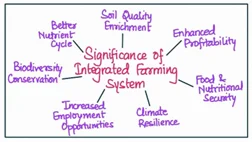Answer:
| Approach:
Introduction
- Define Integrated Farming System
Body
- Mention some of the features of Integrated Farming System.
- Give pointers as to how it is helpful specifically to small and marginal farmers.
Conclusion
- Conclude stating that Integrated Farming System is key to achieving the goal of doubling farmers income by 2022.
|
Introduction:
Integrated farming system is a type of agriculture that aims to create a balanced and sustainable ecosystem by combining different types of farming practices, such as crop production, animal husbandry, and forestry. The combination is such that the waste of one process becomes the input for other processes.
The main goal of integrated farming is to optimize the use of resources, reduce the need for external inputs, and increase the overall productivity and profitability of the farm along with year-round employment.
Body:
According to the Agricultural Census 2015, 86% of Indian farmers are small and marginal farmers. Integrated Farming helps small and marginal farmers in the following ways:

- Reduced use of fertilisers: By reducing the use of chemical fertilisers and recycling nutrients, integrated farming helps reduce input cost and also reduces the chemical content in food as well as soil. IFS also helps in pest and weed control. This is beneficial for S&M farmers who cannot afford to use chemical fertilizers.
- Reduced wastage and financial burden: By IFS, waste from one process gets used up in the other. This reduces wastage and also reduces input cost. Reduced input cost reduces the financial burden on S&M farmers.
- Economic activity: Due to multiple activities being performed on the same piece of land, IFS provides employment all through the year and this flow of money round the year amongst the farming community.
- Nutritional security: Since IFS produces a diverse variety of produce like cereals coupled with poultry, fish, fruits, etc., the malnutrition prevalent due to a single crop diet is corrected.
- Financial security: Most of the S&M farmers are reliant on monsoons for their irrigation needs. Given the high variability experienced in monsoon, agricultural production is always at risk. IFS reduces this risk by providing alternative sources of income in animal husbandry, horticulture, etc.
Conclusion:
IFS provides multiple benefits like optimization of resources, diversification of crops and income sources, etc. but there are multiple challenges too like lack of finance, hesitation towards new methods, etc. India needs to adopt a “well designed” Integrated Farming System (IFS) to realise the vision of doubling farmers’ income by 2022 while ensuring sustainability in agricultural practices.

